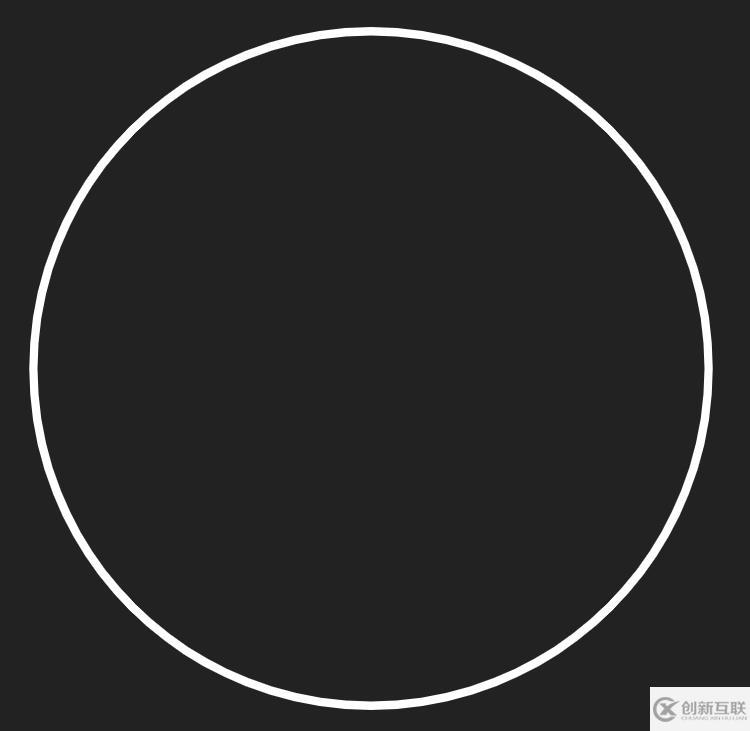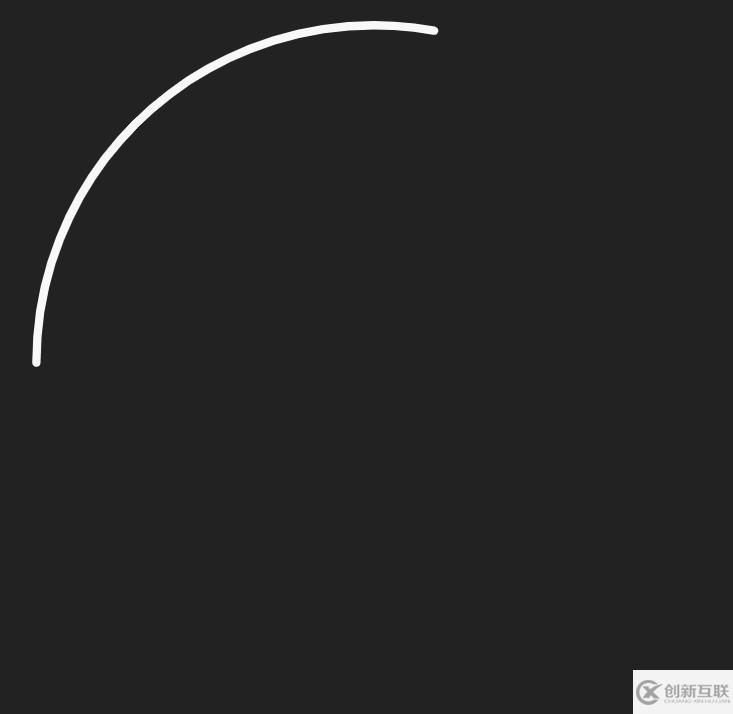怎么用HTML5+CSS3動態(tài)畫一個笑臉
本篇內(nèi)容介紹了“怎么用HTML5+CSS3動態(tài)畫一個笑臉”的有關知識,在實際案例的操作過程中,不少人都會遇到這樣的困境,接下來就讓小編帶領大家學習一下如何處理這些情況吧!希望大家仔細閱讀,能夠學有所成!
成都創(chuàng)新互聯(lián)是專業(yè)的社旗網(wǎng)站建設公司,社旗接單;提供成都做網(wǎng)站、網(wǎng)站建設,網(wǎng)頁設計,網(wǎng)站設計,建網(wǎng)站,PHP網(wǎng)站建設等專業(yè)做網(wǎng)站服務;采用PHP框架,可快速的進行社旗網(wǎng)站開發(fā)網(wǎng)頁制作和功能擴展;專業(yè)做搜索引擎喜愛的網(wǎng)站,專業(yè)的做網(wǎng)站團隊,希望更多企業(yè)前來合作!
今天本文的主要內(nèi)容是:利用HTML5 svg繪制出一個線條笑臉,然后使用CSS3給它添加動畫效果,讓它可以慢慢被畫出來。光說可能大家還不明白是什么效果,我們直接來看看效果圖:

下面我們來研究一下是怎么實現(xiàn)這個效果的:
首先設置整個頁面的背景顏色、svg畫布的大小、線條的顏色、
body {
background: #222;
display: flex;
height: 100vh;
justify-content: center;
align-items: center;
margin: 0;
}
svg {
display: block;
height: 90vmin;
width: 90vmin;
}
.stroke {
stroke-width: 1;
stroke: #fff;
fill: none;
}然后利用svg繪制出一個線條笑臉
定義svg標簽,在當前文檔內(nèi)嵌套一個獨立的svg片段
<svg viewBox="-50 -50 100 100"> </svg>
定義一個path標簽,畫一個圓
<svg viewBox="-50 -50 100 100"> <path class="stroke" d="M-40 0 a 40 40 0 0 1 80 0 a 40 40 0 0 1 -80 0"></path> </svg>

在使用path標簽畫左邊的眼睛
<svg viewBox="-50 -50 100 100"> <path class="stroke" d="M-40 0 a 40 40 0 0 1 80 0 a 40 40 0 0 1 -80 0"></path> <path class="stroke" d="M-20 -20 a 5 5 0 0 1 10 0 a 5 5 0 0 1 -10 0"></path> </svg>

將右邊的眼睛也畫出來
<svg viewBox="-50 -50 100 100"> <path class="stroke" d="M-40 0 a 40 40 0 0 1 80 0 a 40 40 0 0 1 -80 0"></path> <path class="stroke" d="M-20 -20 a 5 5 0 0 1 10 0 a 5 5 0 0 1 -10 0"></path> <path class="stroke" d="M10 -20 a 5 5 0 0 1 10 0 a 5 5 0 0 1 -10 0"></path> </svg>

將嘴巴畫出來
<svg viewBox="-50 -50 100 100"> <path class="stroke" d="M-40 0 a 40 40 0 0 1 80 0 a 40 40 0 0 1 -80 0"></path> <path class="stroke" d="M-20 -20 a 5 5 0 0 1 10 0 a 5 5 0 0 1 -10 0"></path> <path class="stroke" d="M10 -20 a 5 5 0 0 1 10 0 a 5 5 0 0 1 -10 0"></path> <path class="stroke" d="M30 0 a 30 30 0 1 1 -60 0"></path> </svg>

給.stroke元素添加一個stroke-linecaps屬性,將嘴巴路徑兩端的形狀設置為圓弧。
.stroke {
stroke-linecap: round;
}
OK,笑臉畫出來了!最后實現(xiàn)動畫效果:
給.stroke元素綁定一個動畫,然后設置stroke-dasharray和stroke-dashoffset屬性,這樣笑臉圖案會被先隱藏起來
.stroke {
animation: stroke-anim 2s linear forwards;
stroke-dasharray: 300;
stroke-dashoffset: 300;
}使用@keyframes規(guī)則,給動畫設置動作,將stroke-dashoffsets屬性的值設置為0,這樣笑臉圖案就能慢慢顯示出來
@keyframes stroke-anim {
to {
stroke-dashoffset: 0;
}
}
動畫效果雖然出來了,但不是我們想要的。我們需要使用animation-delay定義每一步動作的開始時間,先畫出臉,再畫左眼和右眼,最后畫出嘴巴:
.stroke:nth-child(2) {
animation-delay: 2s;
}
.stroke:nth-child(3) {
animation-delay: 3s;
}
.stroke:nth-child(4) {
animation-delay: 4s;
}
@keyframes stroke-anim {
to {
stroke-dashoffset: 0;
}
}
ok,完成!下面給出完整代碼:
<!DOCTYPE html>
<html>
<head>
<meta charset="utf-8">
<style>
body {
background: #222;
display: flex;
height: 100vh;
justify-content: center;
align-items: center;
margin: 0;
}
svg {
display: block;
height: 90vmin;
width: 90vmin;
}
.stroke {
stroke-width: 1;
stroke: #fff;
fill: none;
stroke-linecap: round;
animation: stroke-anim 2s linear forwards;
stroke-dasharray: 300;
stroke-dashoffset: 300;
}
.stroke:nth-child(2) {
animation-delay: 2s;
}
.stroke:nth-child(3) {
animation-delay: 3s;
}
.stroke:nth-child(4) {
animation-delay: 4s;
}
@keyframes stroke-anim {
to {
stroke-dashoffset: 0;
}
}
</style>
</head>
<body>
<svg viewBox="-50 -50 100 100">
<path class="stroke" d="M-40 0 a 40 40 0 0 1 80 0 a 40 40 0 0 1 -80 0"></path>
<path class="stroke" d="M-20 -20 a 5 5 0 0 1 10 0 a 5 5 0 0 1 -10 0"></path>
<path class="stroke" d="M10 -20 a 5 5 0 0 1 10 0 a 5 5 0 0 1 -10 0"></path>
<path class="stroke" d="M30 0 a 30 30 0 1 1 -60 0"></path>
</svg>
</body>
</html>大家可以直接復制以上代碼,在本地進行運行演示。
這里給大家介紹幾個關鍵的標簽和屬性:
<svg>元素
SVG 圖像是使用各種元素創(chuàng)建的,這些元素分別應用于矢量圖像的結構、繪制與布局。如果svg不是根元素,svg 元素可以用于在當前文檔(比如說,一個HTML文檔)內(nèi)嵌套一個獨立的svg片段 。 這個獨立片段擁有獨立的視口和坐標系統(tǒng)。
<path>路徑
path元素是用來定義形狀的通用元素。所有的基本形狀都可以用path元素來創(chuàng)建。SVG <path>元素用于繪制由直線,圓弧,曲線等組合而成的高級形狀,帶或不帶填充。該 <path>元素可能是所有元素中最先進,最通用的SVG形狀。它可能也是最難掌握的元素。
animation屬性和@keyframes規(guī)則
/* 定義動畫*/
@keyframes 動畫名稱{
/* 樣式規(guī)則*/
}
/* 將它應用于元素 */
.element {
animation-name: 動畫名稱(在@keyframes中已經(jīng)聲明好的);
/* 或使用動畫簡寫屬性*/
animation: 動畫名稱 1s ...
}animation 屬性是一個簡寫屬性,可用于設置六個動畫屬性:
animation-name:規(guī)定需要綁定到選擇器的 keyframe 名稱。。 animation-duration:規(guī)定完成動畫所花費的時間,以秒或毫秒計。 animation-timing-function:規(guī)定動畫的速度曲線。 animation-delay:規(guī)定在動畫開始之前的延遲。 animation-iteration-count:規(guī)定動畫應該播放的次數(shù)。 animation-direction:規(guī)定是否應該輪流反向播放動畫。
animation-delay屬性定義動畫何時開始。該屬性值以秒或毫秒計;允許負值,-2s 使動畫馬上開始,但跳過 2 秒進入動畫。
:nth-child()選擇器:nth-child(n) 選擇器匹配父元素中的第 n 個子元素,元素類型沒有限制。
n 可以是一個數(shù)字,一個關鍵字,或者一個公式。
“怎么用HTML5+CSS3動態(tài)畫一個笑臉”的內(nèi)容就介紹到這里了,感謝大家的閱讀。如果想了解更多行業(yè)相關的知識可以關注創(chuàng)新互聯(lián)網(wǎng)站,小編將為大家輸出更多高質量的實用文章!
網(wǎng)頁標題:怎么用HTML5+CSS3動態(tài)畫一個笑臉
轉載源于:http://www.chinadenli.net/article36/joegpg.html
成都網(wǎng)站建設公司_創(chuàng)新互聯(lián),為您提供定制網(wǎng)站、企業(yè)建站、全網(wǎng)營銷推廣、網(wǎng)站制作、網(wǎng)站排名、品牌網(wǎng)站設計
聲明:本網(wǎng)站發(fā)布的內(nèi)容(圖片、視頻和文字)以用戶投稿、用戶轉載內(nèi)容為主,如果涉及侵權請盡快告知,我們將會在第一時間刪除。文章觀點不代表本網(wǎng)站立場,如需處理請聯(lián)系客服。電話:028-86922220;郵箱:631063699@qq.com。內(nèi)容未經(jīng)允許不得轉載,或轉載時需注明來源: 創(chuàng)新互聯(lián)

- 企業(yè)網(wǎng)站建設為什么要選擇虛擬主機? 2022-06-06
- 北京網(wǎng)站建設之服務器和虛擬主機空間常見問題? 2021-05-31
- 虛擬主機網(wǎng)站空間配置詳解大全 2023-01-17
- vps主機不能取代虛擬主機的四大理由 2022-10-10
- 企業(yè)網(wǎng)站建站中虛擬主機空間選擇的問題 2014-01-27
- 虛擬主機哪里的好? 2022-07-16
- 虛擬主機有哪些優(yōu)點? 2022-12-06
- 企業(yè)建站選擇美國虛擬主機怎么樣 2021-02-15
- 虛擬主機使用獨立IP的優(yōu)勢? 2022-07-21
- 成都虛擬主機的網(wǎng)站遷移方法 2023-02-20
- 網(wǎng)站運營技巧中 如何選擇網(wǎng)站虛擬主機 2013-07-31
- 如何選擇合適的虛擬主機,小站長如何選擇好的虛擬主機呢 2022-06-04